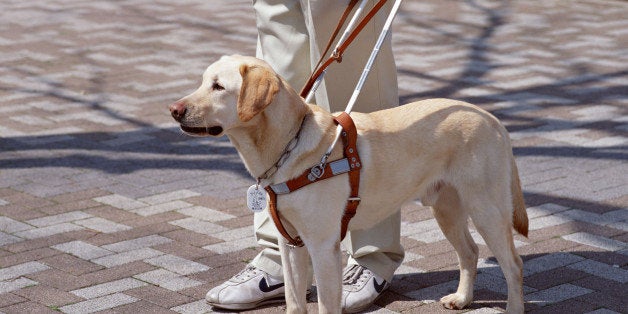
On a windy night in San Francisco, I dropped my ticket while waiting for the last train home. I panicked. Without the ticket, I was stuck at the station for the night. I reached for my phone to call for help, but there was no reception in the tunnel. Then, I felt Madge rub her head against my knee. I reached down to touch her face and realized she had the ticket in her mouth. I had always discouraged my guide dog from picking things up off the ground. Fortunately for me, when she saw my distress, she abandoned her training.
It's absolutely amazing to have a partner who is always watching out for danger. Sometimes, it's almost as if my guide dog could talk to me. Looking back, though, I was hesitant to get a dog.
I was 26 when I lost my sight and had to learn to walk all over again. Each step I took in the dark was drenched in uncertainty. After I started using a cane, and as I learned how to maneuver through mobility classes, my fear slowly dissipated. My instructor said I'd be a good candidate for a guide dog, but, at the time, the thought of caring for one was overwhelming.
A few months later, I was struggling to cross a busy street with my cane when I heard a woman and her guide dog speed confidently past me. I continued to waver in traffic until a stranger who could see helped me across. He suggested I get a dog. That was the moment I began to seriously explore the idea of a guide dog.
Passing the Test
People began using guide dogs in Germany to help soldiers who had been disabled in World War I. The first guide dog training school in the U.S. -- The Seeing Eye -- was founded in 1929. Many people erroneously refer to guide dogs as "seeing eye dogs" due to the name of this inaugural school. There are now about a dozen training schools in the U.S., and the service dog world is expanding to include dogs for deaf people, diabetics, and even those with autism and post traumatic stress disorder (PTSD).
After researching online, I applied to three different schools and then watched anxiously as about half my friends who had applied were rejected.
Getting a guide dog requires a thorough application process, because training the dogs is expensive. Although each school's requirements were slightly different, all three required medical verification of blindness, letters of recommendation, and a personal statement about how having a guide dog would affect my life.
Each school visited my home to verify my skills with the cane and to see how I would handle a dog. They simulated having a guide dog by making me hold a harness and then letting an instructor guide me through crowded Mission Street in San Francisco.
Ultimately, all three schools accepted me, but I chose Guide Dogs for the Blind in San Rafael. This is where I eventually met Madge.
Madge and Oslo
Even though I grew up with pets that I loved, receiving Madge brought a whole new level of connection to my life. And when she began to slow down -- being overwhelmed at airports and in busy streets -- I knew from our connection that it was time for her to retire.
Dogs age faster than people and the average retirement age for guide dogs is 8. The blind person is able to keep the retired dog as a pet and get a second one. But, with my busy travel schedule, Madge would have spent a lot of time alone. Thus, I had my sister adopt her instead.
I think it's important for people to realize that, in many ways, guide dogs are just a regular dog: they get plenty of time for fun, and their reward for their work is affection, food, and play, which they get daily.
On a balmy August afternoon, an instructor at Guide Dogs for the Blind walked into my San Rafael dormitory and presented Oslo to me. It was love at first touch.
After I lost my sight, it became really hard to meet people in public places. I can't make eye contact, smile at someone from across the room, or know if someone is available to talk, so I struggle to strike up conversations and make new friends. Oslo, however, is the perfect icebreaker. Men, women, kids, and other dogs are drawn to him. He makes me more approachable to people who can see, and he loves the attention. (Remember that guide dogs are working, and it's important to ask for permission before petting one.)
It's my love life that has been most affected by Oslo. I can't date anyone with dog allergies, phobias, or a general aversion to dog hair. Once upon a time, I dated guys with flashy clothes and cars. But having Oslo now means most of my romantic relationships are with outdoorsy guys who have dogs of their own and plastic bags constantly on hand.
Working Together
Guide dogs are trained to alert their owners about any changes in elevation, like steps, bumps, or tree roots. They can find doors, seats, stairs, or elevators, and they warn us of things at eye level, like tree branches. Dogs can also read facial expressions.
Once a dog and his owner form a connection, the dog can learn things specific to the person. A friend of mine taught her dog to hit the elevator button in the building where she works. Oslo knows I love pizza, so he always stops when we pass pizza parlors to see if I want to go in.
My constant canine friend comes with me on work trips, vacations, and social outings. When I could see, I used to admire guide dogs that led people across busy intersections and protected them from traffic. Now that I know firsthand what it's like to have this kind of friend, I love telling people about it. It's incredible to have someone who is constantly watching over you. For some, a friend or a mate does this. For me, it's my guide dog.
Belo Cipriani is a freelance journalist, the award-winning author of Blind: A Memoir and Midday Dreams, the spokesperson for Guide Dogs for the Blind and the national spokesman for 100 Percent Wine -- a premium winery that donates 100 percent of proceeds to nonprofits that help people with disabilities find work. Learn more at www.BeloCipriani.com. You are also invited to connect with him on Facebook, Twitter, Google+ and YouTube.
